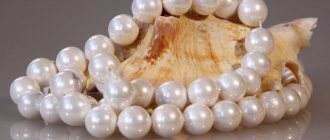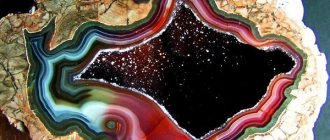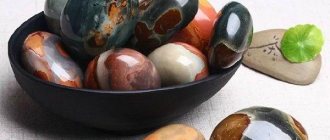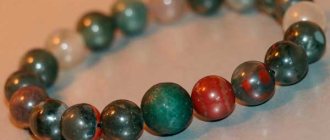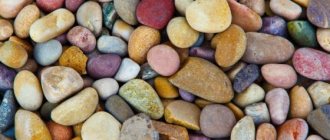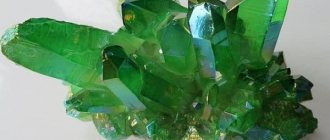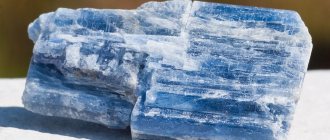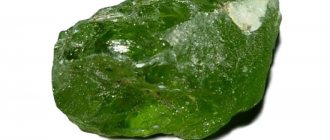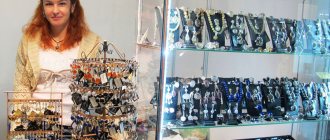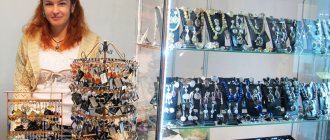| Category | Silicate minerals |
| Title in English | Rhodonite |
| Formula | Mn2+SiO3 |
| Group | Silicate group |
| Color | Red, Pink |
| Stroke color | White |
| Shine | Glass |
| Transparency | Transparent, Translucent |
| singonia | Triclinic |
| Hardness | 6 |
| Cleavage | Perfect |
| Density, g/cm³ | 3,5 — 3,75 |
| Kink | Uneven |
| origin of name | There are two theories according to which the name rhodonite came about. The first uses the Greek word rhodos, which translates as “pink color.” In another theory, the stone is named after the rose flower. |
The word “rhodonite” is of Greek origin and is translated as “rose”, because its color is very similar to the rich color of red roses. In terms of its value in the Urals, this mineral is second only to malachite. There, people often found pieces of the mineral in the nests of eagles, which is why people began to call them “eagles.” Residents of the Urals believed that rhodonite should be attached next to the cradle so that the newborn would grow vigilant and strong, like an eagle.
Rhodonite deposits
The first known rhodolite deposits were discovered in the Urals at the end of the 18th century.
Today the mineral is mined in Australia (Queensland, New South Wales) and Madagascar. In addition, its suppliers are Spain, England, USA, Mexico, Japan, and Central Asian countries. — Advertising —
In general, rhodonite is one of the minerals widespread in nature. Its formation occurs through the transformation of carbonate sediments, which tend to accumulate manganese in the form of carbonate or oxide along with chalcedony. During metamorphism, these compounds turn into rhodonites, bustamites and tephroites. In addition, the formation of rhodonite occurs in polymetallic deposits at points of contact between limestone and granitoid or on cracks in limestone.
Tendency to disease
Since the breed is very hardy, it has good immunity, which provides high resistance to diseases. If inflammatory processes occur in the bird’s body (which is quite rare), then there is an error in the conditions of keeping and caring for the chickens. If you clean the chicken coop on time (at least once a month), and whitewash the walls and wooden components of the poultry house in spring and autumn, you can safely avoid infection with any infections.
Periodic preventive examinations include examining the chickens' feathers for the presence of foreign objects, including mites and other insects. If any deviations from the norm are detected, the diseased parts of the body are treated with insecticides. Bathing in sand and ash, as a unique method of chicken hygiene, allows you to get rid of parasites, so it is advisable to place wide, knocked down boxes with such fillers in the walking area.
Some of the most common infections and inflammations include the following:
- pullorosis, a frequent consequence of which is death (closed eyes, drooping wings, lack of appetite, excessive breathing, thirst, diarrhea or, conversely, constipation);
- gastroenteritis (symptoms of intestinal disorder);
- mycoplasmosis (swelling under the eyes, sounds and screams previously unusual for the bird);
- parasitic inflammation caused by helminths, ticks, fleas or bedbugs (diarrhea, loose stools, bloating, vomiting, unpleasant odor from the beak, general lethargy, fatigue and exhaustion);
- pasteurellosis (foamy nasal discharge with mucus, fever, yellow feces);
- salmonellosis (depression, drowsiness, muscle weakness, difficulty breathing, nasal discharge, sometimes lacrimation);
- coccidiosis - damage to the mucous membrane of the gastrointestinal tract of poultry (frequent diarrhea with the presence of mucous, sometimes bloody elements);
- bronchitis (reduced level or absence of egg production, cough, wheezing, apathy, drowsiness, heaviness in breathing, constant opening of the beak, subsequent addition of conjunctivitis and rhinitis);
- tuberculosis (sharp weight loss due to complete lack of appetite, pallor of the comb, wrinkled earrings).
Salmonellosis is the most dangerous possible disease, since it can be transmitted to humans through contaminated eggs and meat.
History of rhodonite
The term "rhodonite" comes from the Greek "rhodon", which means "rose".
The mineral is also known as dawn stone, pink stone, fowlerite, orlets, ruby and pink spar. The inhabitants of Byzantium knew the gem, but it was rare and therefore little known. Ural deposits with high-quality rhodonites were discovered only in the 18th century, and since then the mineral has taken second place in popularity after malachite. Rhodonite was used to make vessels, candlesticks, tabletops and other decorative items.
The color palette of one of the varieties of stone, which combines pink and black, matches the mourning theme. For this reason, the largest product made from rhodonite was the tombstone of Princess Maria Alexandrovna (wife of Emperor Alexander II). The sarcophagus was made of rhodonite weighing 47 tons.
Feeding conditions
When it comes to nutrition, quats are unpretentious, but when choosing feed, it is better for the keeper to be guided by the developed regulations, approaching the solution of this problem responsibly, since feeding directly affects the overall quality of the resulting product.
Chickens, fluffies aged from a week to one and a half months (about 40 days) can be given mixed feed and gradually transferred to a diet containing more greens and cereals, including: ground wheat, corn and barley, the diet can be enriched with pumpkin and vegetables.
It is worth highlighting crushed shell rock and chalk as additives rich in minerals that form a dense egg shell; feeding with fishmeal is also allowed. Laying hens during the period of active egg laying should be given ground shells and eggshells.
According to the “color” criterion, the brown pigment of the egg shell of these chickens received excellent reviews among poultry farmers. It is also worth agreeing with the fact that this particular color is considered to be an advantage over its white counterparts.
Physico-chemical characteristics of rhodonite
— Advertising —
The composition of rhodonite includes oxides of manganese, iron, calcium and silicon.
The formation of crystals occurs poorly; more often, rhodonite is a dense confluent or fine-grained mass with a glassy sheen, imperfect cleavage, uneven fracture, transparent or translucent.
Hardness on the Mohs scale 5.5-6. Specific gravity 3.5-3.7 g/cm3.
Types of rhodonite
For rhodonite, according to color characteristics, several subspecies are distinguished:
- Fowlerites – contain yellow-brown inclusions.
- Ribbon rhodonites - with alternating pink, brown and gray stripes.
- Bustamites have a pinkish-gray cut with a pronounced black dendritic pattern.
- “Mourning rhodonite” – contains more black color; monuments and tombstones are often made from it.
Magical properties of rhodonite
Rhodonite helps a person in acquiring material goods, in particular objects of art.
Stones with black veins protect against robberies; for this purpose, purchase a figurine or other interior decoration. It is believed that rhodonites are associated with the beginning of life - they become good helpers for young people who crave success and recognition. The gem reveals everyone’s abilities and talents, helps in their development and successful use. Rodnite, on the one hand, stimulates the creative activity of its owner, and on the other, helps to cope with laziness. For this, singers, musicians, writers, and designers are recommended to use keychains and bracelets made from this mineral. The stone will strengthen self-confidence, recharge with energy, and bring inspiration.
There is also a connection between rhodonite and the family tree; the mineral promotes the veneration of one’s family. It is recognized as an excellent family amulet that protects the family from all negative influences, disputes and conflicts. With the help of rhodonite, a lonely young man will definitely become a favorite among women and a happy person in love. Rhodonites are often given to newlyweds as a strong protective amulet.
Rhodonite takes on the bad emotions of its owner. The mineral improves mood, develops sadness, teaches love and joy in life.
Rhodonite, which has been correctly charged by a psychic or its owner, radiates positive energy for a long time.
As a summary
In this article we touched on the main and most significant features of Rhodonite chickens. What are the reviews? Summarizing the main characteristics, we can display the following graph of the advantages of the cross:
- high egg production;
- satisfactory survival of young animals;
- adaptability to bear at negative temperatures.
Whether to start breeding this selection or to abstain – the decision must be made personally by the applicant. Experts recommend buying chickens from large poultry farms.
It is not difficult to distinguish females and males, and the presence of a “commander” in the flock is completely unnecessary if your plans do not include offspring. The egg production rate of laying hens is not “tied” to this factor.
However, experienced poultry farmers recommend having at least one leader to maintain “discipline” in the chicken coop.
It can be additionally noted that this hybrid will be an excellent start for beginners planning to start a poultry farm or, moreover, to open their own business.
That's basically it. Prosperity and success to you!
Don’t forget to subscribe to site updates to be the first to receive new articles about cockerels and quons. Share the material with your friends on social networks - they will also be interested in reading about highly productive laying hens.
Did you like our tips? Share with friends on social media. networks!
Healing properties of rhodonite
Since ancient times, people have believed that rhodonite is a talisman for women that helps during pregnancy and childbirth.
It was believed that if you give it to a bride at a wedding, she will soon become pregnant. Sometimes even gynecologists leave rhodonite in their robe pocket as a talisman for a good birth. In lithotherapy, rhodonite is recommended for diseases of the thyroid gland. The stone helps strengthen the immune system, improve memory, and relieve stress. The mineral has a positive effect on the functioning of the heart and blood vessels. In the East, rhodonite was used for eye diseases and to strengthen vision.
In Ancient China, they believed that every owner of rhodonite in case of illness would receive secret knowledge about how to cure it.
Breeding
The bird's incubation instinct is completely lost, and it will not be possible to place the female on the eggs. To hatch chicks, you must use an incubator or a hen of a different breed.
The characteristics of rhodonite roosters are very good: they perform their duties efficiently, ensuring egg fertility of about 97%.
The correct sex ratio in the herd allows you to obtain high-quality incubation material. For 4 hens you need 1 rooster.
When there is only 1 rooster in the herd, and there are many females, to obtain a fertilized egg, it is best to place 4 hens with a male separately for a couple of weeks. The egg obtained from these laid out females must be put into incubation.
Raising chickens
Raising chickens is not difficult, but it requires compliance with certain rules. Poultry chicks have minimal mortality and often the entire brood survives to adulthood.
Immediately after hatching, the chick is transferred from the incubator to a brooder or heated box. It is best to warm young animals using an infrared lamp.
If there are few chicks, then you can warm them up using a blue lamp. The bottom of the box is covered with soft white cotton cloth, and in the brooder it is covered with sawdust.
The chicks should be fed immediately after they are dry. They should be given a hard-boiled egg, finely chopped along with the shell. They should also be given some crushed wheat.
The egg is left for 30 minutes, after which everything uneaten is removed so that the food does not begin to deteriorate. Crushed cereal is left for babies around the clock so that they can eat as soon as they want.
From the second day, cottage cheese and greens are introduced into the diet of young animals. Vitamin supplements are also started. From 2 weeks, the chicks begin to be fed little by little with fish and meat (can be replaced with worms).
To raise high-quality laying hens, you need to give your chickens green onions every day.
The drinking bowl should always be available. Its contents are changed at least 3 times a day, since even slightly spoiled water will cause serious problems with the chickens.
In the first days, you can add a little potassium permanganate to the water: after it is dissolved, the water should practically not change color.
Chicks are taken out for walking in warm and dry weather, starting at 2 weeks. Young animals are left to roam all day long in good weather from the age of 1 month.
Even a beginner can grow rhodonite, but, of course, if all recommendations are followed. Chicks do not require special conditions, which is especially appreciated by breeders.
Branches of application of rhodonite
Rhodonite is used as an ornamental and jewelry stone.
Particularly popular are its samples with black dendrites and veins of manganese hydroxides and oxides, with brown areas of bustamites, fibrous inesites and other inclusions. All of them give the mineral “landscape patterns”, which look very attractive in jewelry. At the same time, a large number of manganese oxides and hydroxides in rhodonite increase its porosity and reduce its strength. Rhodonite is also exposed to air moisture, and at high humidity it can completely turn black. It is important to consider these properties when making and purchasing jewelry with gems.
During weathering of rhodonite rocks, manganese ores are formed.
Rhodonite colors
The color range of rhodonite includes shades of scarlet, crimson, pink, sometimes with gray and black veins.
Lilac-violet “cobalt” rhodonites were also discovered in the Urals. There are also some other colored varieties of stone, depending on the content of impurities. The highest quality rhodonite should contain manganese dendrites and specks on one third of its surface, and very little yellowish or grayish (up to 10%). A rare translucent variety with a bright crimson-red, almost ruby color is also especially valued in jewelry.
Description
Chickens of the Rhodonite breed have light bones and a horizontal body position. The head is proportional, the beak is yellow, with a brown stripe at the base. The comb is medium-sized, leaf-shaped, not falling to the side. The earrings are red. The lobes are paler, pearlescent pink. The tail is moderately bushy, set high, with short braids in roosters. The back is wide, the belly is voluminous, the chest is convex, the shoulders are poorly developed, the wings are small. The legs are short, yellow, with light brown scales in front.
The plumage is dense, fawn, light brown or red. The collar on the neck has a golden tint. The feathers on the wings and tail are lighter. The character is accommodating, the birds can be kept with other breeds. Chickens are stress-resistant. They quickly get used to a new place and are not afraid of people.
How to distinguish real rhodonite from a fake
Processed specimens of rhodonite are considered valuable; they are quite difficult to counterfeit. When buying a stone, they study its color, pattern on the surface and inclusions. Pay attention to the weight of the stone - plastic imitations are always very light. They also check the temperature of the crystal - a natural one will heat up slowly. In addition, natural rhodonite does not have cracks, scratches or other defects.
Content
Rhodonite - chickens are unpretentious, and keeping them is not difficult. For them, it is only important to provide a draft-free shed (you can use a polycarbonate greenhouse) and a paddock where they can expend energy.
In order for the chickens to feel comfortable at night, they are given roosts. The nests should be the size of the chickens and attached to the wall at a height of about 80 cm. Ideally, 1 nest should be made for 3 chickens.
The floor of the poultry house should be well covered with sand, peat moss, hay or sawdust.
Rhodonite chicken, like any other, does not like dampness, and therefore it is necessary to maintain a comfortable environment in the poultry house. A chicken coop with an area of 10 m2 is enough for 20 birds.
To ensure that egg production does not decrease, in winter the temperature in the poultry house is maintained at least -2 degrees.
The bird will not die even at -20, but its laying will become much worse: once every 3–4 days. Heat is also not good for laying hens, and if the house is warmer than +28 degrees, the number of eggs will decrease significantly.
To cool the chicken coop, use either a ventilation system or, at home, wet sheets hung on 2 walls.
Care
Caring for a bird is not at all difficult. To ensure that representatives of the breed of chickens do not get sick, it is necessary to ventilate the poultry house in a timely manner, and also clean it 3 times a year.
To prevent the appearance of parasites, once a year the walls of the barn are whitewashed with lime. In the summer, it is good to treat the chicken coop in the absence of birds with special antiseptic bombs.
When walking, you need to make a fence high enough so that the rhodonites do not flutter over it. Their wings are quite strong and, with a low weight, rhodonites can overcome a barrier of 150 cm.
Birds are checked for parasites in their feathers once a month. To inspect, the bird should be lifted by the legs and held with your hand against the feathers, carefully looking at their awns.
If parasites are found, laying hens should be treated with a special product for productive birds or, if the flock is small, with Bars flea drops for cats. Their quantity is calculated based on the weight of the chicken.
If the care is satisfactory, then the hens lay eggs regularly and do not get sick. If the condition of the pets worsens, you need to look for your mistakes in their maintenance.
How to care for rhodonite
As a soft and fragile stone, rhodonite requires careful and careful handling. It is not exposed to high temperatures and chemicals, but may turn black if left in very humid areas (swimming pool, sauna, bathhouse) for a long time. To clean rhodonite, use soapy water and a soft cloth. Rhodonite products can be stored together with other soft minerals.
Talismans, amulets, amulets
Rhodonite beads
A talisman or amulet can be a pebble, jewelry or other mineral product:
- A keychain with a pebble will relieve laziness and inspire you to do great things.
- The bracelet will raise self-esteem and awaken inspiration. Attribute of public figures. It must be worn on the left hand.
- Small plastic, another beautiful thing - a guarantor of home peace. Rhodonite does not tolerate brawlers, intriguers, or envious people. A useful gift for newlyweds.
- Rhodonite in a pocket or ring is a talisman for fans of gambling and risky people.
A pink stone can restore hope even to a person who has lost faith in everything and everyone.
To recharge rhodonite, one meditates on it. At the same time, the owner calms down.
Rhodonite and zodiac sign
Astrologers recommend rhodonite, first of all, to Libra and Gemini, but in general there are no contraindications to its use. It is important to remember that the influence of a gem does not appear immediately, but after it has “become close” to its owner. Rhodonite is worn in rings and pendants; just a pebble in a clothing pocket is also suitable as a talisman.
Reviews from poultry farmers
Svetlana, 55 years old, Krasnoturinsk
These chickens were taken, as they say, “from the author”: straight from the Sverdlovsk breeding plant. I took 20 pieces, 3 of them were cockerels. All the chicks survived; the hens began laying eggs at about 4.5 months. The result impressed me: the eggs are very tasty, each laying hen produces about 260 eggs per year. This, of course, is less than at a poultry farm, but I cannot create “factory” conditions and I don’t need it. My birds live in an insulated barn, and in the summer they roam in an aviary. In winter they lay eggs regularly. They eat more than outbred animals, but they also “work off” their feeding to the fullest. But I wasn’t happy with the cockerels: I slaughtered them and got classic broth carcasses. There is not enough meat, it is “rubbery” and does not taste very good. Now my rhodonites are almost 2 years old. Apparently, the herd will soon need to be renewed. I’ll buy chickens there again, but I won’t buy any more cockerels. And I really liked the laying hens.
Ivan, 45 years old, Samara
Nice cross, the laying hens suit me completely. The eggs are excellent, you get a lot of them (more than 250 eggs per year from each). I have already brought a hatching egg from a breeding farm twice and hatched it in an incubator. There were no problems - fertility and hatchability were quite decent. The chickens also turn out strong, and there is almost no waste. The meat of cockerels, however, is “nothing”, but these chickens are bred for their eggs. And I will continue to do so.
Stepan, 59 years old, Moscow region
As an egg cross, this cross is one of the best. Laying hens work great even in winter. They are unpretentious, eat quite a lot, but are not capricious. Only their reproduction has gone awry. I tried to get offspring from my own chickens. The chickens were hatched (under a hen of a different breed), but they were very “unique.” Apparently, the same thing happens here as with other hybrids, that is, parental qualities are not inherited. But this is not very critical for maintaining a flock, because purebred chickens can be found on sale, and the price is relatively low.
Prices for rhodonite products
The price for a high quality raw stone with a dendritic pattern is approximately $10 per kg, pink rhodonite is valued at $9 per kg, and other types are approximately $5 per kg.
Jewelry with processed inserts costs much more. For example, beads are estimated at 20-30 dollars, the cost of silver earrings is about 70 dollars.
Interesting facts about rhodonite
- On the main staircase of the Hermitage there are decorations - rhodonite floor lamps 280 cm high. This museum also houses an oval vase 85 cm high and 185 cm in diameter.
- A monument to the classic of French literature, Henri Barbusse (Paris), was created from rhodonite.
- Rhodonite was used as a finishing material to decorate Moscow metro stations.
Video
We invite you to watch several videos filmed by experienced poultry farmers who work with Rodonite chickens and share tips from their own practice:
About the author:
Found a mistake? Select the text with the mouse and click:
Ctrl + Enter
Do you know that:
A new product from American developers is the Tertill robot, which weeds weeds in the garden. The device was invented under the leadership of John Downes (creator of the robot vacuum cleaner) and works autonomously in all weather conditions, moving over uneven surfaces on wheels. At the same time, it cuts off all plants below 3 cm with the built-in trimmer.
